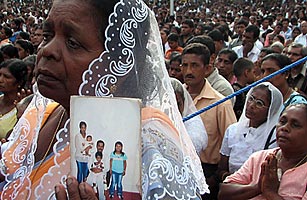CARETAKE OF MADHU REV. EMILIANUS PILLAI SAYS TAMIL TIGERS BROKE THEIR AGREEMENT WITH THEM AND MOVED FIGHTING INSIDE THE CHURCH
Posted on August 17th, 2009
By Walter Jayawardhana
Rev. S. Emilianus Pillai one time caretaker of the Madhu shrine told the Time magazine that the Liberation Tigers of Tamil Eelam (LTTE) broke an agreement with the church not to move into the church compound, and moved mortar launchers in the church property and started firing for hours.
Telling his main concern was the safety of the statue the Catholic pries also added, ƒÆ’‚¢ƒ¢-¡‚¬ƒ…-I went into the Shrine and hid there. The shelling went on for hours.ƒÆ’‚¢ƒ¢-¡‚¬ƒ”š‚

Rev. Father Emilianus Pillai further told the Time that he was concerned about the safety of the place because the Tamil Tigers used the church premises to launch an attack on the government forces.
The Time magazine said ƒÆ’‚¢ƒ¢-¡‚¬ƒ…-Late on that same afternoon, the priests received orders from the bishop to remove the sacred relic and take it further north, deeper into Tiger-held areas, rather than risk heading for the front. The journey early that evening starting at 6.30 pm , however, was still fraught. Rev. Emilianuspillai recalls not just shelling but a heavy rain delaying departure and then, one kilometer into the journey, a shell falling near the vehicle in front of the one bearing the statue. But, he says, “nothing, absolutely nothing happened to the statue. We kept moving.ƒÆ’‚¢ƒ¢-¡‚¬ƒ”š‚
The last year of the civil war, said the Time magazine, had been particularly perilous for the Shrine. The military had begun a multi-pronged advance into the Tiger controlled area in late 2007 and Madhu lay about 10 km north of the line. Earlier that year, 10,000 people were still taking refuge in the church compound, believing the Virgin would protect them. But by February 2008, recalls then then-caretaker of the Shrine, the Rev. S. Emilianuspillai, it was clear that the Shrine itself was in danger ƒÆ’‚¢ƒ¢-¡‚¬ƒ¢¢”š¬‚ and part of the war. On April 3, 2008, fighting had isolated 17 persons at the Shrine including four priests, and three nuns. Rev. Emilianuspillai told TIME that the Tigers, breaking an agreement not to enter the compound, had moved mortar launchers in the church property and started firing. Says Rev. Emilianuspillai: “I went into the Shrine and hid there. The shelling went on for hours.”
The Time magazine further reported that the chief concern was the safety of the statue, now that the compound was being used to launch attacks on government forces. Late on that same afternoon, the priests received orders from the bishop to remove the sacred relic and take it further north, deeper into Tiger-held areas, rather than risk heading for the front. The journey early that evening starting at 6.30 pm , however, was still fraught. Rev. Emilianuspillai recalls not just shelling but a heavy rain delaying departure and then, one kilometer into the journey, a shell falling near the vehicle in front of the one bearing the statue. But, he says, “nothing, absolutely nothing happened to the statue. We kept moving.”
ƒÆ’‚¢ƒ¢-¡‚¬ƒ…-The statue had been in grave danger before ƒÆ’‚¢ƒ¢-¡‚¬ƒ¢¢”š¬‚ in the late 17th century when the Protestant Dutch tried to eradicate the Roman Catholicism brought to the island by the Portuguese. The Virgin Mother had been moved from the Shrine then as well. By July 2008, the statue was in a more secure spot. And by November 2008, the statue was once again in the shrine, in time for the outpouring of piety on this year’s Feast of the Assumption.ƒÆ’‚¢ƒ¢-¡‚¬ƒ”š‚
For Catholics around the world, August 15 is among the holiest of feast days. It marks the Assumption of the Virgin Mary, when the mother of Jesus is believed to have been taken, physically, into heaven after death so her body would not suffer earthly decay. For the Catholics of Sri Lanka, August 15 this year marks a similar miracle: the survival of a 500-year-old statue of the Virgin, through the fiery tumult of a quarter-century civil war, to be re-ensconced in her, said the magazine.
For 25 years, Madhu, some 300 km from the capital Colombo, remained well-within the battle grounds of the civil war between the predominantly Sinhalese government and the separatist Tamil Tigers. It was not until April 2008 that the military gained full control of the shrine; the Tigers, who demanded a separate state for ethnic Tamils in the island nation, were finally crushed in May 2009, the magazine reported.